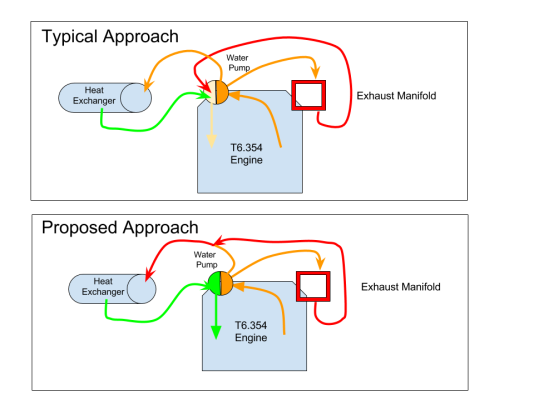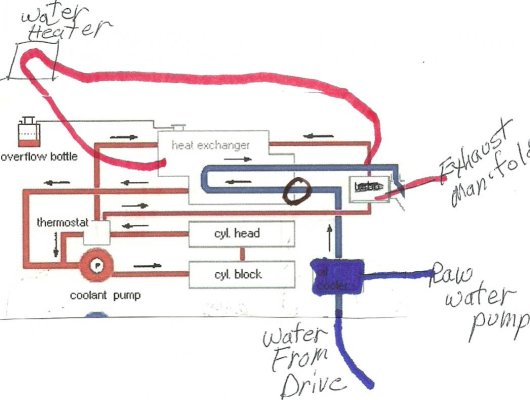R_p_ryan
Senior Member
- Joined
- Dec 11, 2014
- Messages
- 171
- Location
- USA
- Vessel Name
- Shellbourne
- Vessel Make
- 1978 Mainship 34 Perkins T6.354
I'm consolidating some discussions from various posts into a dedicated thread on converting the raw water cooled exhaust manifold to the fresh water coolant circuit. Some of the information is interesting on BoatDiesel.com but it doesn't really get into the details, and doesn't address running at WOT.
I have found four write-ups from people who have done it and they typically result in some overheating. In one case it was resolved by increasing the size of the heat exchanger.
The typical way is to use the ports at the freshwater pump that were designed for a cab heater and are commonly used to heat a hot water tank for the house. The original design is the water coming back would be cooler or possibly the same temperature. Using this flow results in hot water getting extra-hot, then going straight back into the engine.
I believe a better approach is to add a bung on the 2" pipe that takes hot water to heat exchanger. This is where the hot water is returned from the manifold. This way the extra-heated water goes through the exchanger before going back into the engine. It also increases the flow of coolant through the heat exchanger. The typical approach decreases the flow through the heat exchanger since the water pumped through the manifold goes straight to the pump intake.
Here are some diagrams. Does this make sense?
Thanks,
RR
I have found four write-ups from people who have done it and they typically result in some overheating. In one case it was resolved by increasing the size of the heat exchanger.
The typical way is to use the ports at the freshwater pump that were designed for a cab heater and are commonly used to heat a hot water tank for the house. The original design is the water coming back would be cooler or possibly the same temperature. Using this flow results in hot water getting extra-hot, then going straight back into the engine.
I believe a better approach is to add a bung on the 2" pipe that takes hot water to heat exchanger. This is where the hot water is returned from the manifold. This way the extra-heated water goes through the exchanger before going back into the engine. It also increases the flow of coolant through the heat exchanger. The typical approach decreases the flow through the heat exchanger since the water pumped through the manifold goes straight to the pump intake.
Here are some diagrams. Does this make sense?
Thanks,
RR


